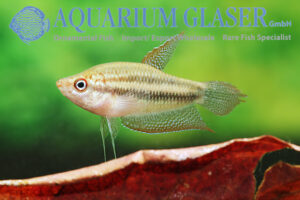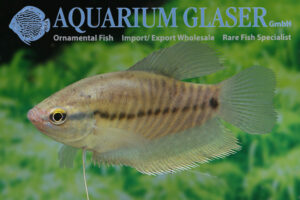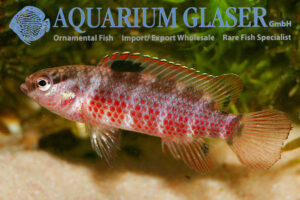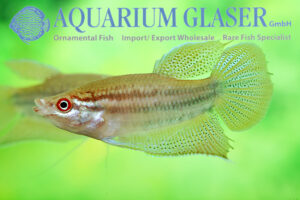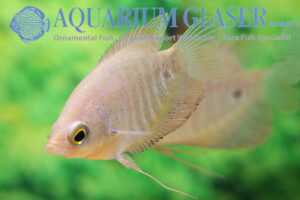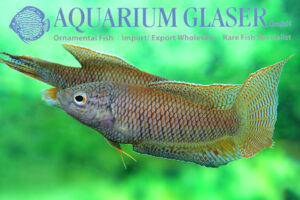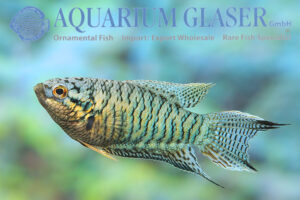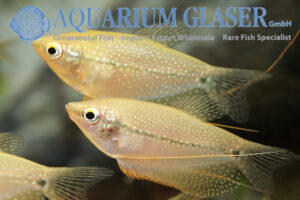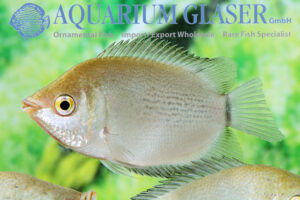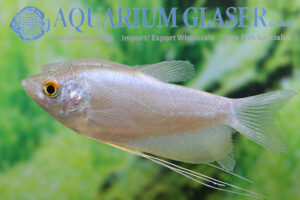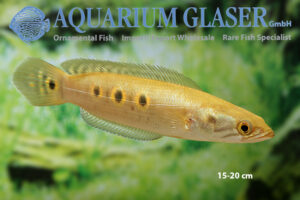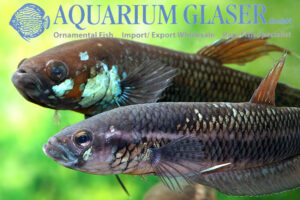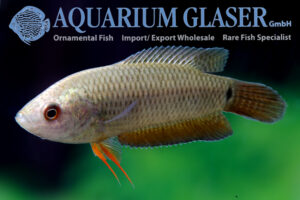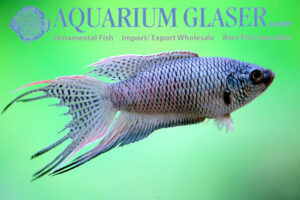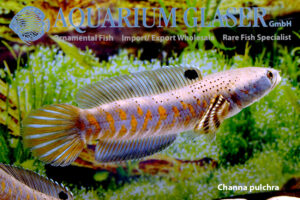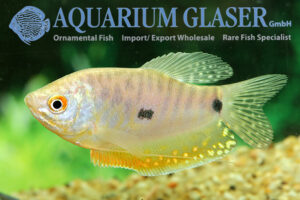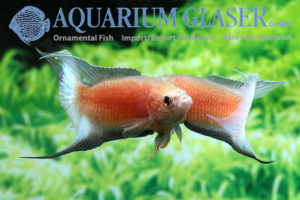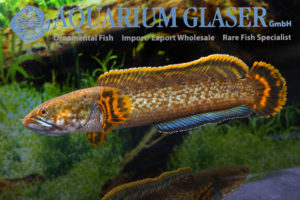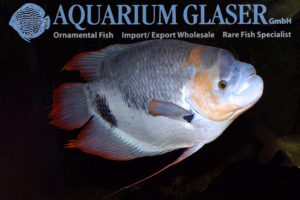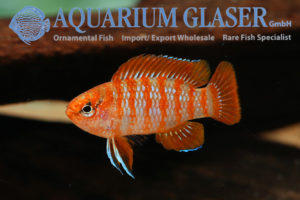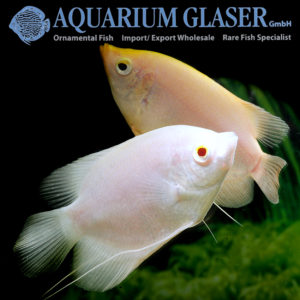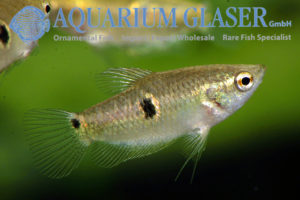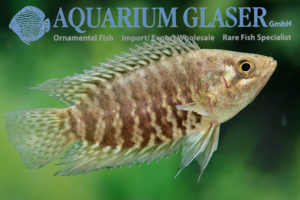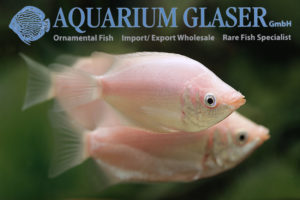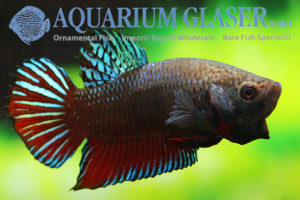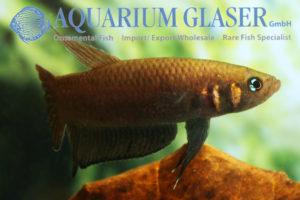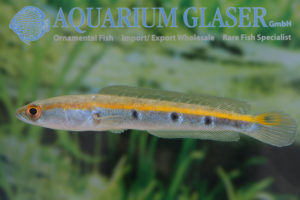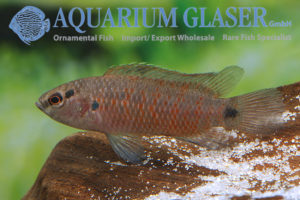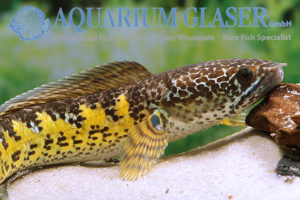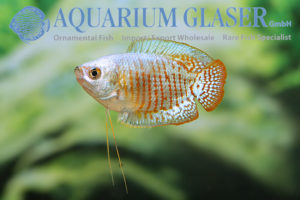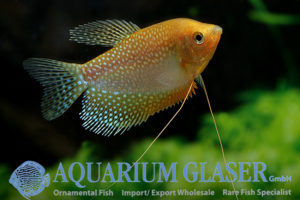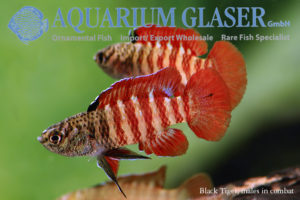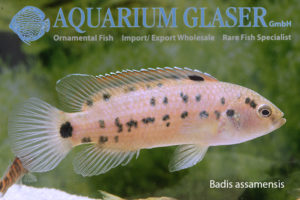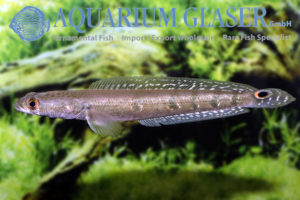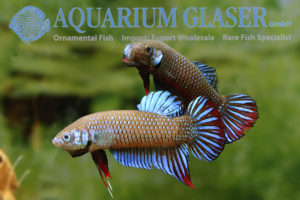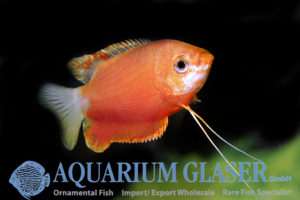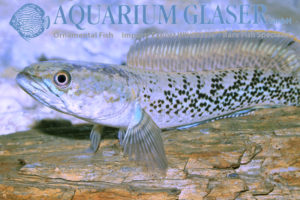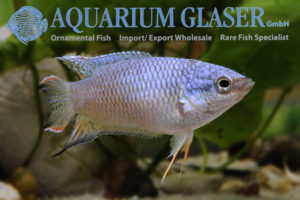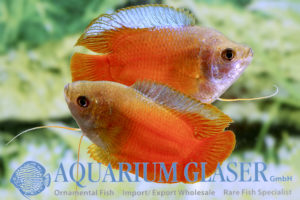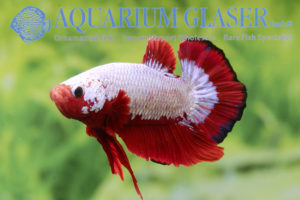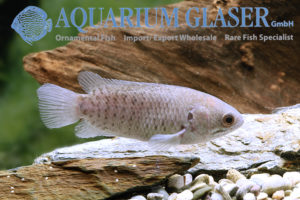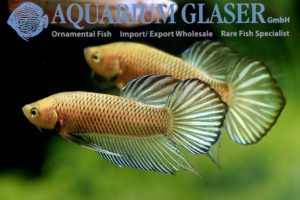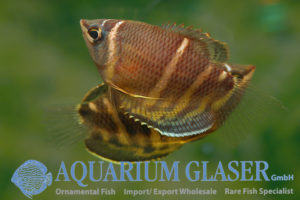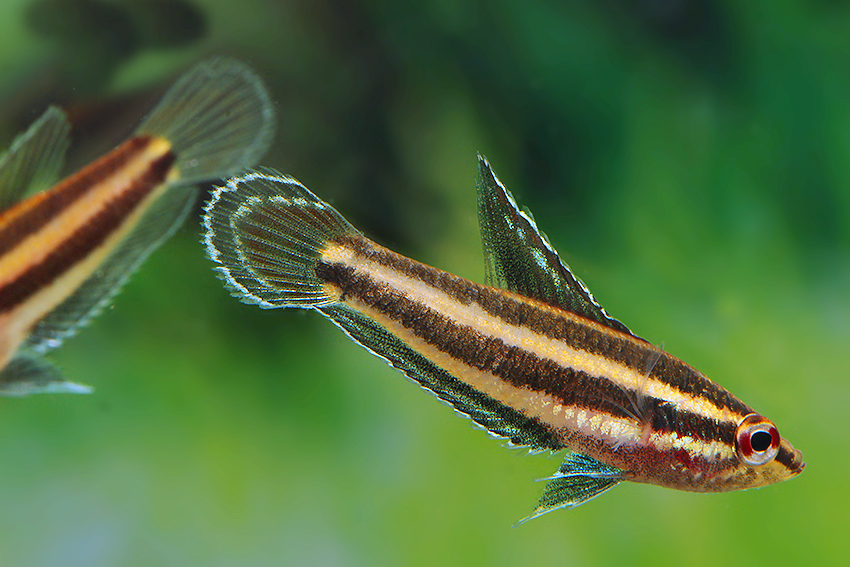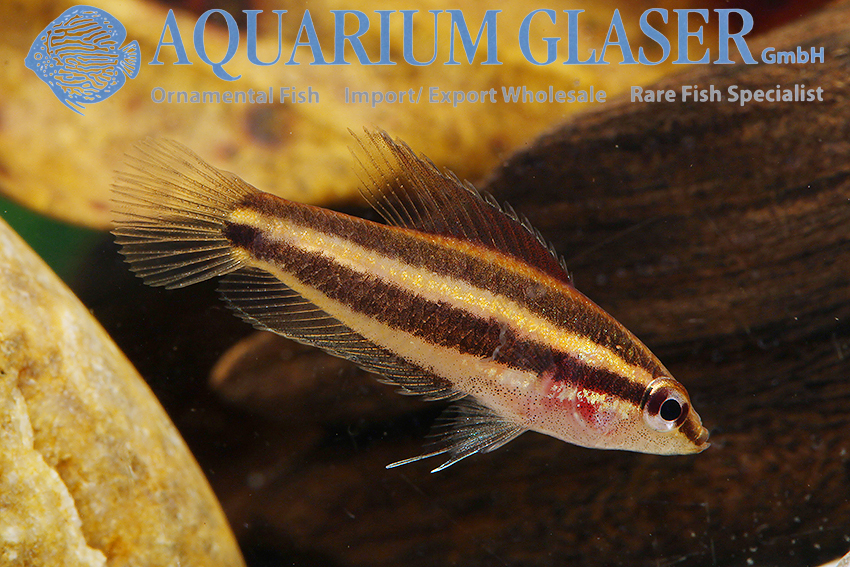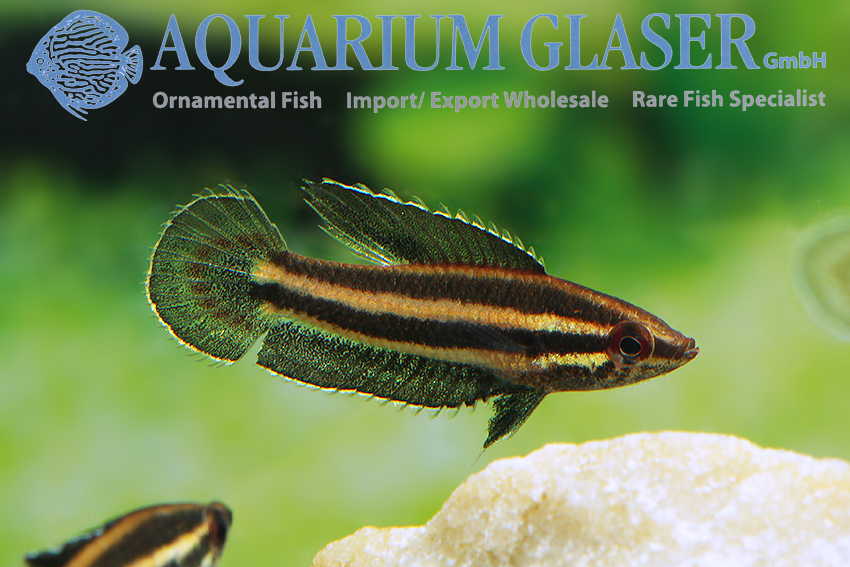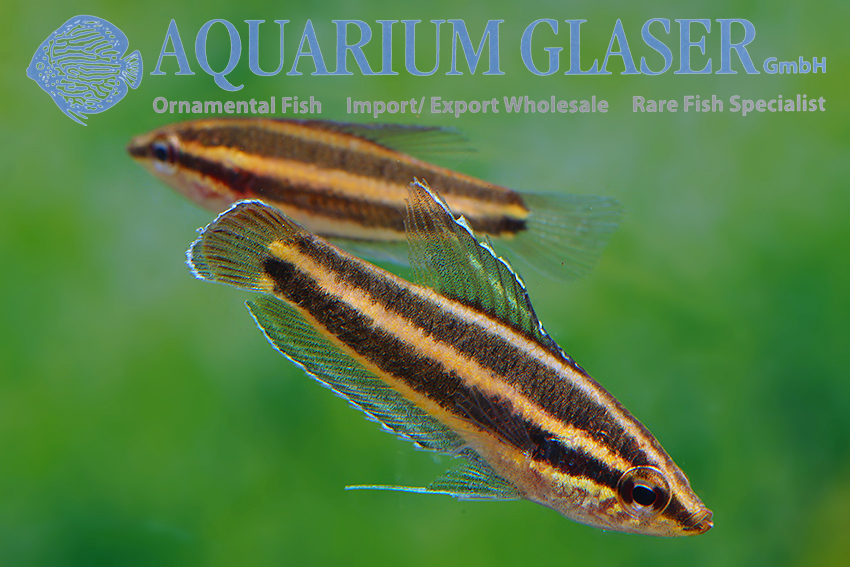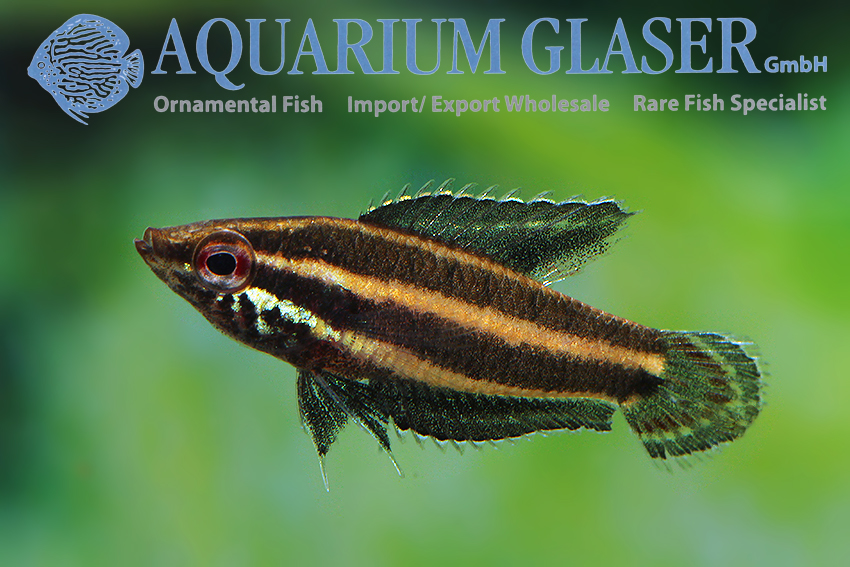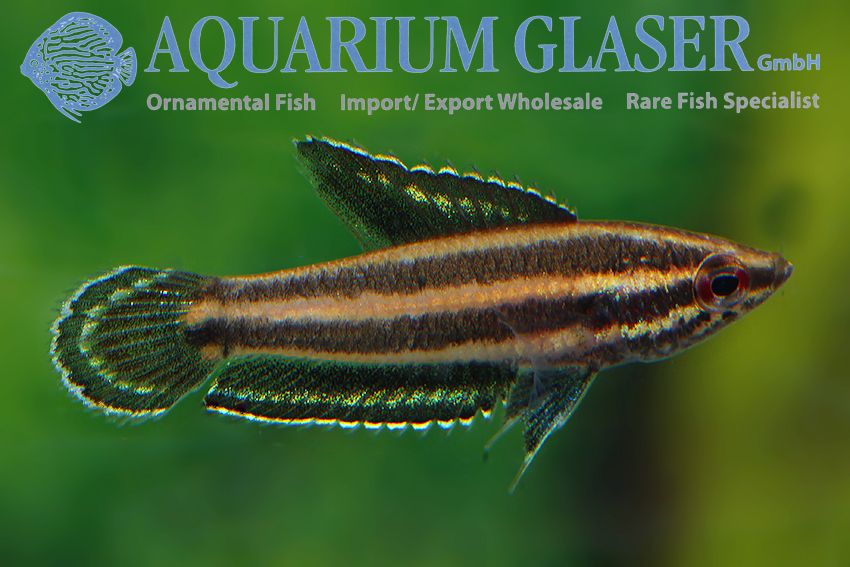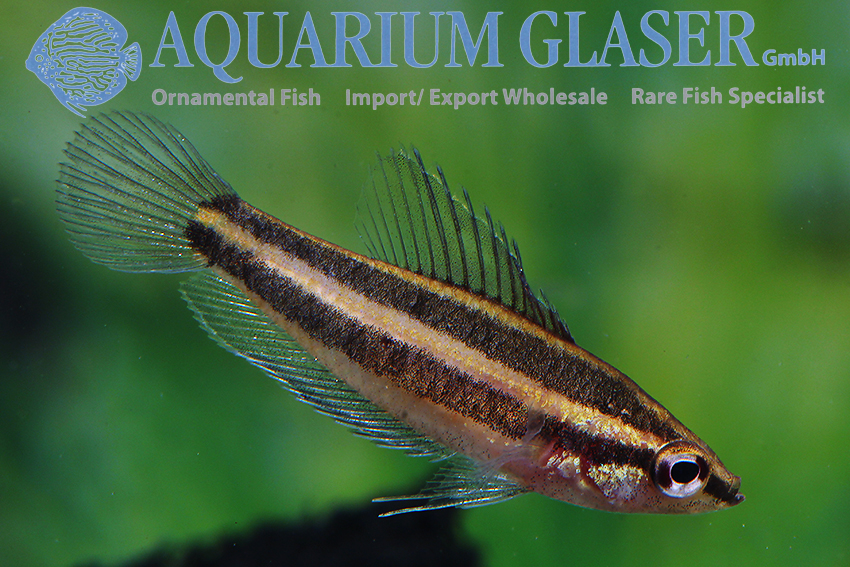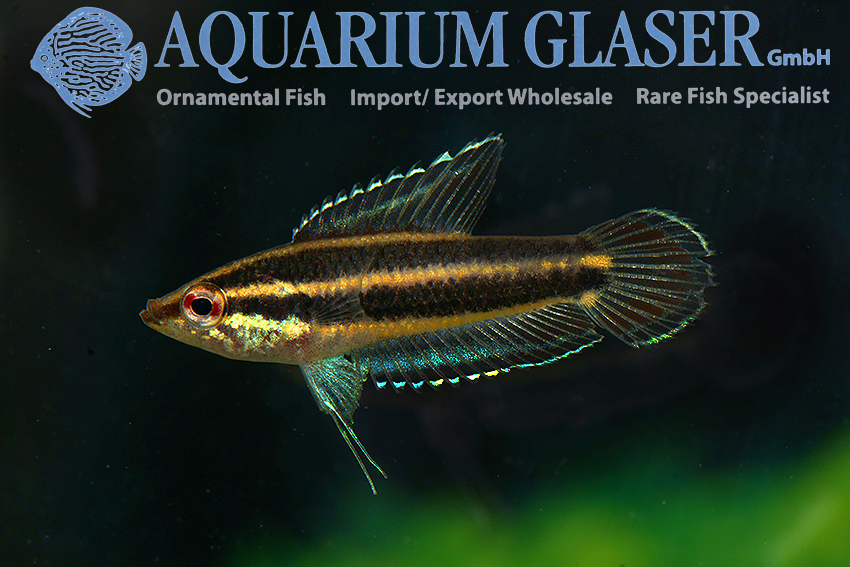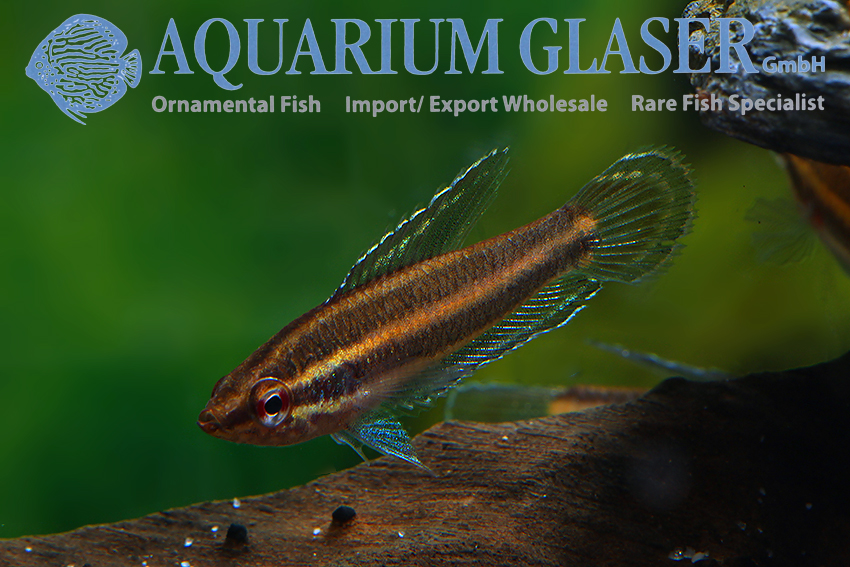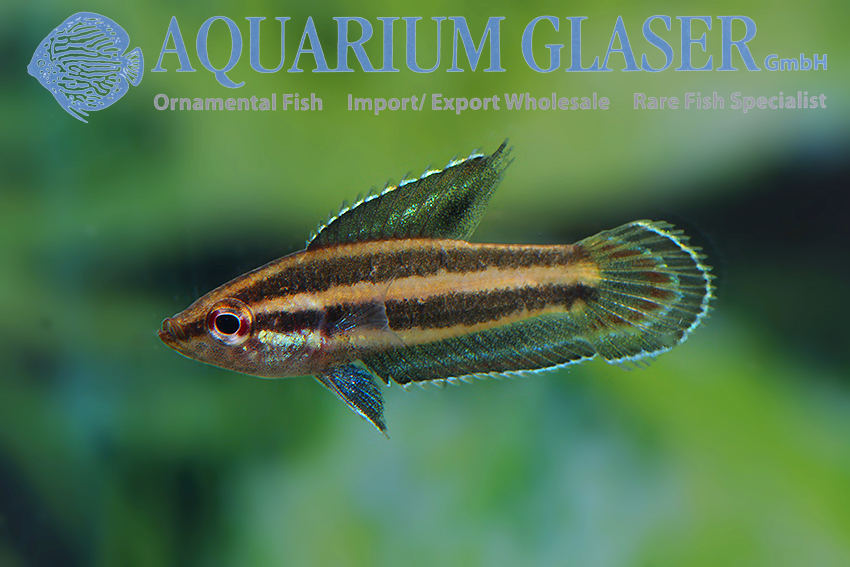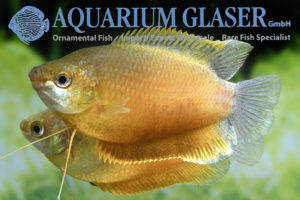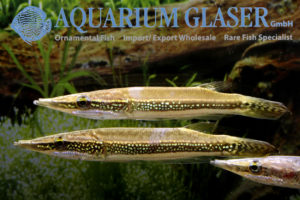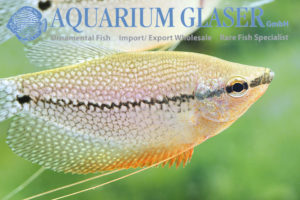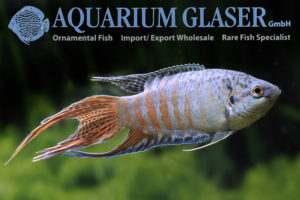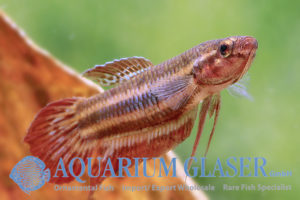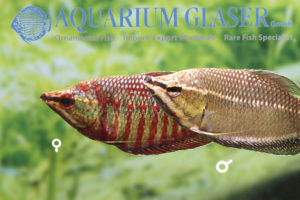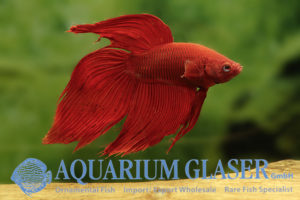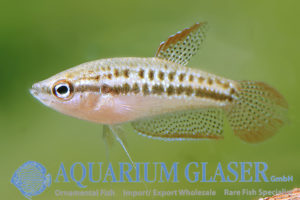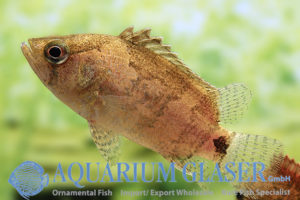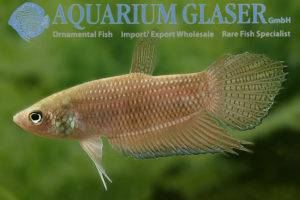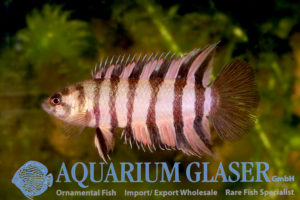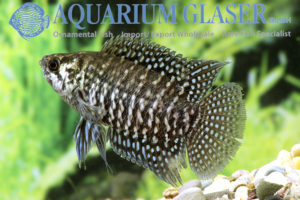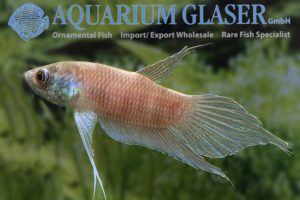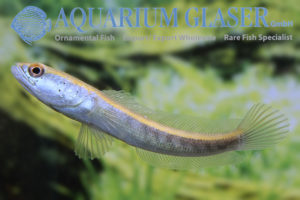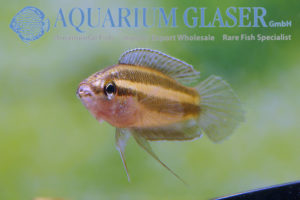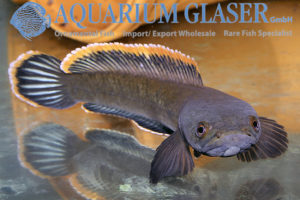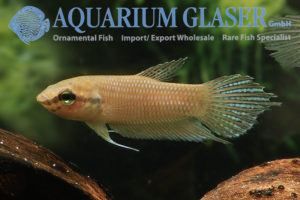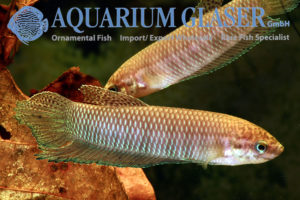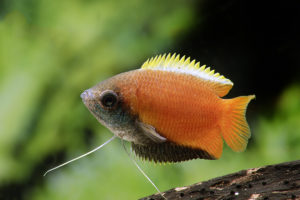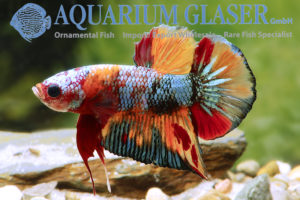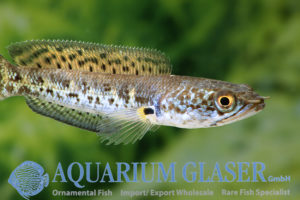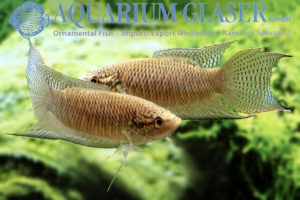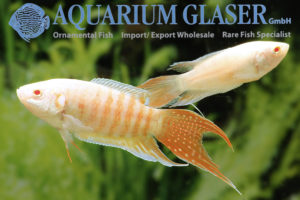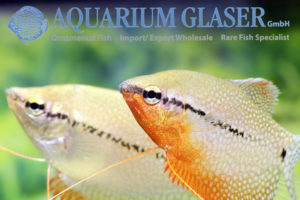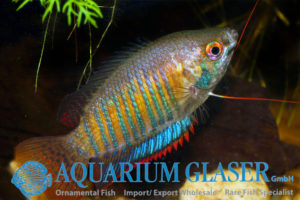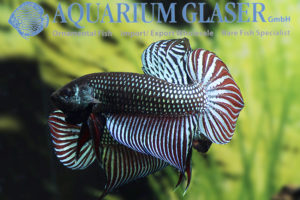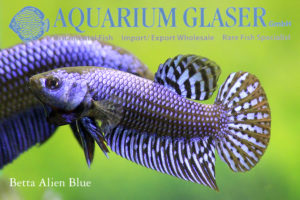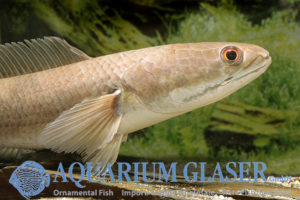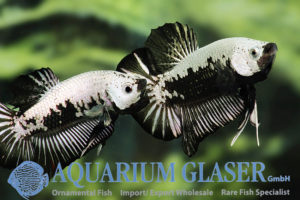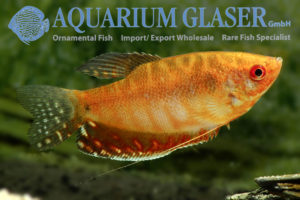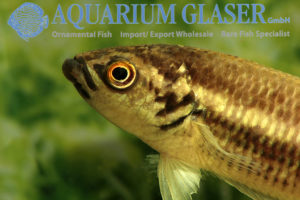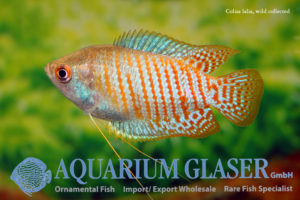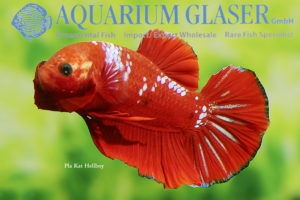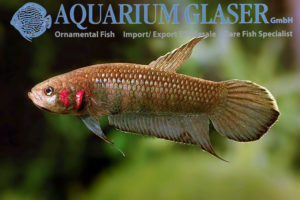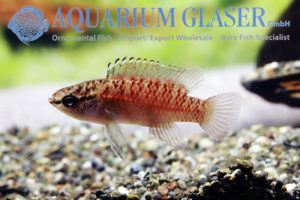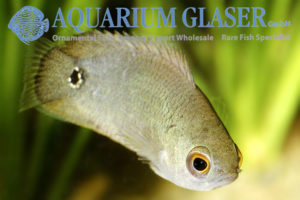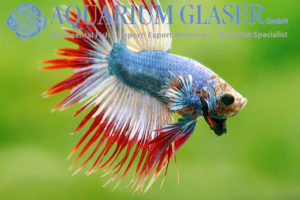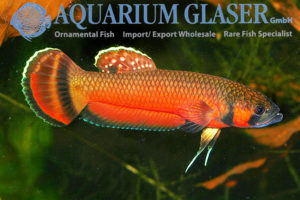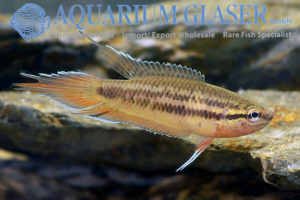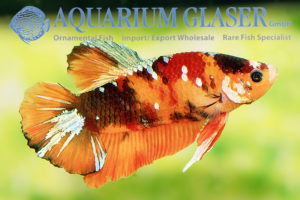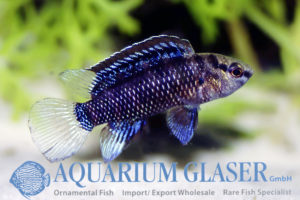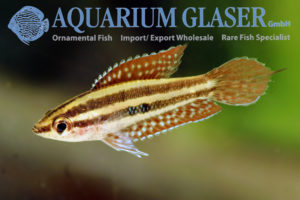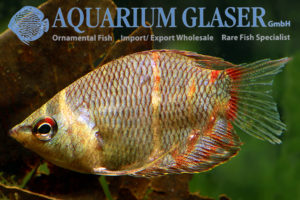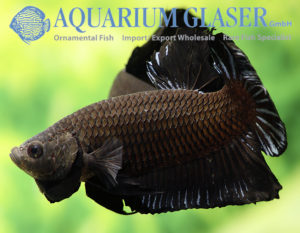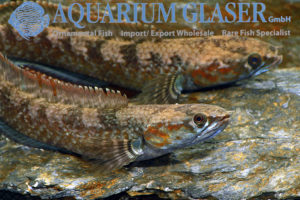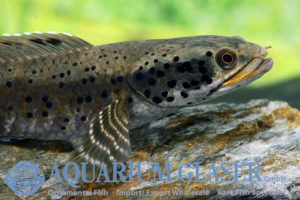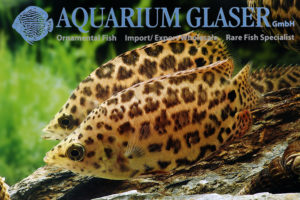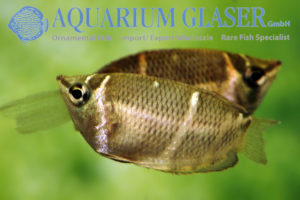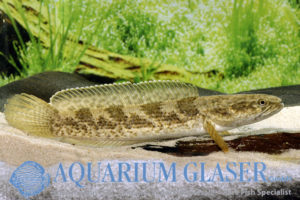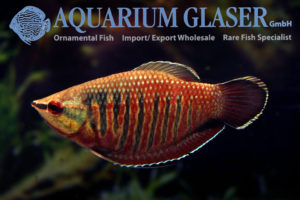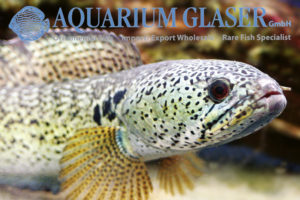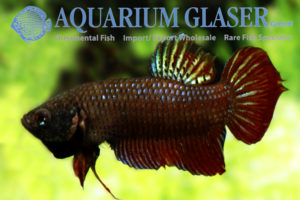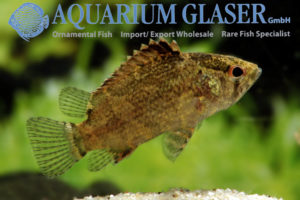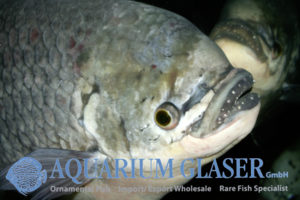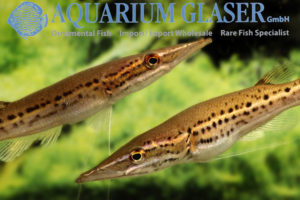Schaller’s Croaking Gourami is one of the unfortunately rarely available labyrinth fish. These pretty animals mostly come from central Thailand (they can be found comparatively far north and also in Vietnam) and grow to around 4 cm in length. This makes them slightly larger than the Dwarf Croaking Gurami (Trichopsis pumila 2.5-3 cm) and slightly […]
25a: Perchlike fishes (1): Labyrinth fishes (194)
-
-
Trichogaster pectoralis
The snakeskin gourami (Trichogaster pectoralis) is the largest and most peaceful species of gourami. The animals can become 20-25 cm long and are therefore in their homeland Southeast Asia also estimated food fish. However, we prefer to enjoy their calm nature and beautiful coloration. For years there has been a dispute about the correct genus […]
-
Badis singenensis ( = sp. Buxar)
Badis singenensis ( = sp. Buxar) A beautiful, small chameleon fish (Badis) originates from the north of India, which has a reduced swim bladder as a special feature within the genus. As a result, it is very bottom-bound and moves around somewhat hopping. The maximum length of this species is approx. 4-5 cm including the […]
-
Trichopsis vittata
The Croaking Gourami (Trichopsis vittata) is perhaps the most common small fish in South East Asia. It grows to 4 – 6.5 cm long. It can be found almost everywhere, except in strongly flowing waters and in the mountains. Freshly caught, the Croaking Gourami is usually very attractively coloured and shimmers in different shades of […]
-
Osphronemus goramy
Most people only know giant gouramis (Osphronemus goramy) from the zoo. There, these somewhat overgrown-looking animals (but that’s the way it should be) – the largest labyrinth fish of all – usually swim peacefully in the company of other large fish from Southeast Asia. However, the juvenile fish not only look completely different, but also […]
-
Macropodus erythropterus
The paradise fish (Macropodus) can be roughly divided into three groups: the black paradise fish with the described species M. hongkongensis, M. erythropterus, M. lineatus, M. minnanensis, M. oligolepis, M. phongnhaensis, M. spechti, M. tramiensis and M. yeni, the blue-red paradise fish with the described species M. baviensis, M. chinensis, M. filamentosus, M. opercularis and […]
-
Macropodus “Blue Tiger“
It is only very recently that we have begun to realize that the diversity of species of paradise fish (Macropodus) is much greater than we thought possible. Basically, three main groups can be distinguished in this genus, whose representatives are at home in China, Vietnam and Korea: Round-tailed paradise fish (M. ocellatus and related species), […]
-
Trichogaster leerii WILD JAMBI
Wild-caught pearl gourami (Trichogaster leerii or Trichopodus leerii) are hardly ever available on the market. In fact, the exact distribution of this gourami species, which is present in the hobby since 1933 and has never disappeared since then, is more anecdotal than scientifically known. It is certain that this species is found on the Malay […]
-
Helostoma temmickii GREEN
The kissing gourami (Helostoma temmickii) is a very popular ornamental fish for larger aquaria due to its unusual “kissing” behavior. Almost exclusively the pink-colored breeding form is available in the trade (see https://www.aquariumglaser.de/en/25-perchlike-fishes/helostoma-temmickii-2/), as this variant is bred in huge quantities as an edible fish. The pink form is much easier to see than the […]
-
Trichogaster microlepis ( = Trichopodus microlepis)
Fish for romantics – does that exist? Occasionally! One of them is certainly the moonshine gourami, Trichogaster microlepis. Its popular name says it all. Although the animal is only silvery-white, its tiny scales give it a very peculiar appearance, as if wrapped in silk. Color always means: communication with conspecifics and bright colors are very […]
-
Channa pleurophthalma
We regularly have perhaps the most beautiful snakehead fish in stock: Channa pleurophthalma. This species, which is found on the Greater Sunda Islands of Sumatra and Borneo and inhabits lakes and rivers there, grows to around 40 cm in length. In contrast to most other snakeheads, they like to swim a lot in open water. […]
-
Betta unimaculata
Modern labyrinth fish science began in the 1980s. At that time, enthusiastic labyrinth fish enthusiasts joined together to form international associations. The world opened up to travelers and areas in Southeast Asia could be visited that had previously only been known from maps. One of the first Betta species to enter the hobby at that […]
-
Pseudosphromenus cupanus
What are the reasons for choosing this or that fish for your home aquarium? In the beginning, it’s probably basically the colors. Over time, you develop a feeling for the wealth of shapes in the realm of fish, then swimming behavior and body shape are added to the selection criteria. And finally, you delve deeper […]
-
Macropodus spechti “Royal Blue”
We have again received a nice number of beautiful domestic offspring of this extraordinarily beautiful black paradise fish (Macropodus spechti “Royal Blue”). For the history of this variant see https://www.aquariumglaser.de/en/25-perchlike-fishes/macropodus-spechti-royal-blue-2/ In the meantime, the fish have been further developed in terms of breeding and are preferably bred with animals that – very similar to Belontia […]
-
Channa pulchra
Sometimes supposedly small details are decisive, for example when it comes to species differences. There are two species of snakehead (Channa) that occur geographically close to each other in Burma (Rakhine State): Channa pulchra and Channa ornatipinnis. Both look quite similar and grow to a similar size (20-25 cm), but they differ considerably in their […]
-
Trichogaster trichopterus ( = Trichopodus t.)
The spotted gourami is one of the most important ornamental fish of all and is one of the top 100 worldwide. The species is extremely widespread in Southeast Asia. Despite its relatively small size (usually 8-10, rarely up to 15 cm), this gourami is used as a food fish and can survive for a long […]
-
Macropodus opercularis: squeaky red!
Solid red paradise fishes (Macropodus opercularis) have been known since the 1990s. However, they could not really establish themselves in the market, because the animals, which were also traded under the fancy name “Macropodus rex”, turned out to be very susceptible to diseases. Apparently the problem has been solved and we have now received really […]
-
Channa brunnea
The Rainbow Snakehead (Channa bleheri) is without doubt one of the most beautiful and colorful snakeheads and with usually 12-15 cm total length (sometimes a bit more) it stays quite small. It originates from the north of India and belongs to the few Channa species without ventral fins. Since 2007 a very similar, also colorful […]
-
Osphronemus laticlavius
Once again we received the rare red-finned giant gourami (Osphronemus laticlavius). Like the common giant gourami this species grows around 60 cm long. The home of the fish is on Borneo, where it probably occurs naturally only in Sabah, i.e. in the very north of the island in the Malayan part. Since about 1985 this […]
-
Dario dario
The Dwarf Badis, also called Scarlet, has transformed itself from the highly paid sensation of the year 2000 to the always available classic in aquaristics. It originates from northern India (North Bengal), where it inhabits clear, moderately flowing waters with sandy bottoms and rich underwater plant growth at the foot of the Himalayas. In terms […]
-
Osphronemus goramy gold and albino
Labyrinth fishes are among the most important ornamental fishes in the world. Their often bright colors and varied behavior make their care very rewarding. Most species also remain small, only very rarely exceeding the 10 centimeter mark. The exception are the giant gouramis (Osphronemus), of which there are four accepted species. They are not only […]
-
Parasphaerichthys ocellatus
This extremely rarely imported species originates from Burma. The charming fish attains a length of only 2-3 cm. The species is a close relative of the mouthbrooding chocolate gouramis, but P. ocellatus is a bubblenest builder although the eggs look like the eggs of mouthbrooders. In the habitats of P. ocellatus appear heavy day-night changes […]
-
Microctenopoma fasciolatum
Unfortunately imports from the Congo are only rarely possible. But now it was once again so far and among other species we have received nice wild catches of the Banded ctenopoma (Microctenopoma fasciolatum, formerly Ctenopoma f.). The currently imported form – the exact locality is unknown to us – differs quite clearly in color from […]
-
Helostoma temmickii
The kissing gourami (Helostoma temmickii) in its pink breeding form is one of the best known labyrinth fish. It is not actually bred as an ornamental fish, but as a food fish. The species grows up to 30 cm long under suitable (fattening) conditions and is considered delicate. In the nutrient-rich, turbid breeding ponds, the […]
-
Betta splendens – real fighter Pla Kat Luk Maw
It is a well known fact that the Betta splendens kept in the aquarium hobby as ornamental fish do not represent the species as it appears in the wild, but a domesticated fish. Initially this sport has been bred for combats, similar like sports of cocks and dogs. Only in the 1920ies, when supplying ornamental […]
-
Betta strohi
The species status of Betta strohi is controversial. It is a form from the species complex around Betta foerschi (see https://www.aquariumglaser.de/en/fish-archives/betta-foerschi-bred/). Some authors consider B. strohi to be a synonym of B. foerschi, others a valid species. “Technically” the two differ by a rather inconspicuous feature, namely the eye line. In Betta strohi the line […]
-
Channa marulius
Which species is the largest snakehead fish? Unfortunately, this question cannot be answered unambiguously, because the expression “angler’s lingo” has already become proverbial for uncertain statements. Anglers (and not only them!) like to exaggerate a little. But indisputable is: Channa marulius from India belongs to the top candidates for the race. The largest documented catch […]
-
Badis pallidus
The flood of newly discovered Badis species does not stop. It is astonishing that 23 new species of these fishes have been scientifically accepted in the last 20 years and only four in the 200 years before! Badis pallidus was only described in 2019; it belongs to the immediate relationship of Badis badis and cannot […]
-
Channa aurantimaculata WILD
We have the probably most beautiful of all snakeheads once again available in limited numbers. This species grows up to 50 cm long in the aquarium, but normally they reach only 20-25 cm in the wild; our currently stocked fish are 14-18 cm long. The species is endemic (i.e. only found there) in northern India. […]
-
Colisa lalia now Trichogaster fasciata?!
For almost 20 years, ichthyologists have disagreed on which rule of the International Rules of Zoological Nomenclature is more important for the gouramis of South and Southeast Asia: the prime directive, according to which everything else must be subordinated to the stability and universal applicability of scientific names, or the various rules that regulate which […]
-
Trichogaster leerii “Gold“
Gold forms – also called xanthorists – are quite common in fish, even in nature. Ever since the beginning of man’s records of natural phenomena, there has been talk of golden perch, carp, crucian carp, tench and pike. Of course, such mutations occur much more often in breeding than in the wild, because there such […]
-
Dario tigris – the “Black Tiger” was scientifically described
The cute Flame Red Dwarf Badis (Dario hysginon) we have quite regularly in our stock. It originates from Burma (drainage of the Irrawaddy, Myitkyina District, Kachin State). More pictures of the species can be found here: https://www.aquariumglaser.de/fischarchiv/dario_hyginon_2__en/ Partly together with the Flame Red another dwarf badis occurs in nature, which is already mentioned in the […]
-
Badis assamensis and Badis blosyrus
In the north of India there are two Badis species, which are indistinguishable by color: B. blosyrus and B. assamensis. The only discernible difference that exists is the size of the mouth cleft. It is much larger in B. blosyrus and reaches below the center of the eye margin, whereas in B. assamensis the mouth […]
-
Channa marulioides
The largest and most splendid of all snakeheads belong to the relationship of Channa marulius. This species occurs in India and attains a maximum length of about 120 cm. The largest specimen ever collected is said to have had a length of 183 cm and a weight of 30 kg. But most often the fish […]
-
Betta imbellis
For many Betta imbellis is the prettiest wild fighting fish at all. Of course, “the” Betta imbellis does not exist at all, because the widespread species looks somewhat different everywhere. It is the sister species to Betta splendens and in fact no human being is able to distinguish completely decolorized specimens of both species from […]
-
Colisa labiosa Ruby Red
Besides the orange colored breeding form of this gourami from Burma (see https://www.aquariumglaser.de/en/fish-archives/colisa-labiosa-orange-2/) there is also a very attractive, deep red colored breeding form. In order to keep these wonderful animals in their bright coloration permanently, it is necessary to provide certain types of food (e.g. Cyclops, Spirulina or also special flake food). Without the […]
-
Channa stewartii
This snakehead, often traded under the name Channa cf. barca, originates from the northern Indian province of Assam. C. stewartii can reach a length of up to 30 cm (usually around 20 cm) and as a predatory fish should only be kept along with fish that are at least 2/3 of its body length. Besides […]
-
Macropodus spechti “Royal Blue”
For the first time we can offer this magnificent breeding form of the black paradise fish. Our breeder writes about it: How did I become aware of these fish: In 2019, I saw a picture of blue paradise fish from Vietnam in a Facebook group for paradise fish lovers by chance. Being skeptical at first […]
-
Colisa lalia “Flame Red
Only from few breeding forms is so well known, when they originated, as with Colisa lalia “Flame Red”. At the same time the fish decorated the covers of all aquaristic journals worldwide in the early 1980s, so sensational were they found. The animals were bred in the Lim Choa Kang area of Singapore, a rural […]
-
Betta splendens Hellboy II
Some time ago we introduced a short-finned fighting fish breeding form (“Pla Kat”) of Betta splendens as “Hellboy”. (https://www.aquariumglaser.de/en/fish-archives/betta-splendens-pla-kat-hellboy-and-giant-halfmoon/). Now we have received Pla Kat under this name from Thailand again, but they differ from the first Hellboys in color and fins. The new Hellboys have a halfmoon tail fin, which means that when the […]
-
Anabas testudineus
There are many criteria, why to choose this or that fish for the aquarium. Those who like colorful fish should avoid Anabas. But who likes to observe biological peculiarities is well advised with the climbing perch. General information about Anabas can be found here: https://www.aquariumglaser.de/fischarchiv/anabas_de/. We have now once again imported climbing perch from Bengal. […]
-
Channa micropeltes
One of the most beautiful freshwater fishes of all is Channa micropeltes. This snakehead lives in groups and its favorite pastime is eating. It is therefore constantly on the lookout for food and swims lively in a shoal through the aquarium. Although every word up to this point is true, it is still only half […]
-
Betta splendens Pla kat Yellow cheek Spadetail
The first documented domesticated form of the Siamese fighting fish (Betta splendens) was a Spadetail. That was in 1849. At that time certainly fighting fishes were bred for a long time, but they resembled more or less the wild fishes and were selected only for their fighting characteristics. The appearance of these animals was a […]
-
Sphaerichthys osphromenoides
The chocolate gourami (Sphaerichthys osphromenoides) still belongs to the legendary ornamental fish species. Although the species is common in the wild and other fish of the same habitat (e.g. harlequin barbs) do not cause significant problems in the aquarium, it is a gamble whether chocolate gouramis will do well there. Possibly this is related to […]
-
Colisa labiosa “Orange”
The identity of Colisa labiosa, a gourami from Burma, is unclear; there is some evidence that the species so named in the hobby is actually not identical with C. labiosa in the sense of the first describer (Day, 1877), but it is much more likely that it is a scientifically not yet named species. But […]
-
Luciocephalus aura
The pikeheads (Luciocephalus) are highly specialized labyrinth fish. They live as predators in blackwaters of Southeast Asia. Only two species are known, the “common” pikehead, which occurs on the Malay Peninsula and in Indonesia, and the Peppermint Pikehead, which is known so far only from the Province Jambi on Sumatra. Currently we are able to […]
-
Trichogaster leerii WILD – Borneo
The pearl gourami (Trichogaster leerii, Trichopodus leerii) is one of the most popular aquarium fishes at all. It is probably not exaggerated if one assumes millions of individuals in aquariums all over the world. All these fish are bred ones. It is only little known that the pearl gourami belongs to the endangered species as […]
-
Macropodus opercularis “Blue“
There are no blue paradise fish in nature, they are a cultivated form with a blue back (vs. red-brown in the wild form). When exactly and in whom the first blue paradise fish appeared is not documented. It must have been in the late 1940s or early 1950s, because from then on they were mentioned […]
-
Betta coccina
Right now we have especially large and beautiful Betta coccina from Indonesia in stock. As the pictures show, this time the males have particularly extensive blue patches on their flanks; the females of Betta coccina generally do not have blue flank scales. Betta coccina can be kept well in groups, but even these comparatively peaceful […]
-
Sphaerichthys vaillanti xxl
From Indonesia we have received extraordinarily beautiful and especially large Sphaerichthys vaillanti. According to our supplier they come from the vicinity of the Danau Senatrum National Park in the part of Borneo belonging to Indonesia called Kalimantan. For more information about this magnificent animal see https://www.aquariumglaser.de/en/fish-archives/sphaerichtys-vaillanti/ Text & photos: Frank Schäfer
-
Betta splendens Veiltail
The history of becoming a domesticated animal is hardly researched for many species and is full of secrets, as it is with Betta splendens. There is some evidence that its true domestication only occurred after the collapse of the Khmer Empire in the 15th century. Before that, Betta splendens had been used for fish fights, […]
-
Trichopsis pumila
The Pygmy gourami, Trichopsis pumila, is one of the prettiest labyrinth fish. With a maximum length of 4 cm (usually it stays one centimeter smaller) it is a real dwarf fish. The species occurs in Thailand, Laos, Vietnam, and Cambodia. Although the species is an obligatory air breather, so would drown if you block its […]
-
Nandus nebulosus
Via Singapore we have once again received Nandus nebulosus in beautiful, fully grown specimens. The species can, like all other leaf fish, change its colouring very fast and drastically, furthermore each specimen has an individually different marble pattern. Some of our new arrivals have a head profile which is much more pointed than expected from […]
-
Betta apollon
Betta apollon was scientifically in 2006 and comes from forest streams in the hilly country west of Narathiwat in Thailand. The mouthbrooding species belongs to the immediate relationship of Betta pugnax. The fish was named after the Greek god Apollon, who stands for beauty and elegance among other things – an aptly chosen name for […]
-
Microctenopoma ansorgii
We have very nice and stable wild catches of the Orange Bushfish from the Congo in our stock. The bubblenest-building species grows to about 6-8 cm, currently the animals are 3-4 cm long. The Orange Bushfish is a very interesting species. It becomes already half grown and sexually mature. With increasing age the fish becomes […]
-
Microctenopoma fasciolatum
Within the African labyrinth fishes, the so-called bushfishes, one can roughly differentiate between two groups: those that do not care for their brood and those in which the males build a foam or bubble nest, into which they are spawned and which is guarded by the male until the young fish are independent. The latter […]
-
Betta raja
With 73 species generally regarded as valid, the genus Betta has become rather confusing and without knowledge of the origin, even specialists find it difficult to identify the species. We have just received very beautiful mouth-breeding Bettas from Sumatra, including Betta raja. Betta raja belongs to the closer relatives of Betta pugnax. The most reliable […]
-
Channa melanoptera
Channa melanoptera from Indonesia belongs with a maximum length of 65 cm to the large Channa species from the species group around Channa marulius. Like all species of this group, C. melanoptera undergoes a drastic colour change from youth to adult. Right now we have lovely young animals of about 4-5 cm length in stock. […]
-
Parosphromenus paludicola
The magnificent licorice gouramis (Parosphromenus) are among the most threatened fish species on earth. This is due to the extensive destruction of the environment in their habitats. Most of the currently 20 scientifically described species have only been discovered in the last 40 years thanks to aquarium science, as the licorice gouramis differ mainly in […]
-
Channa sp. Laos Fireback
For the first time we received this splendid snakehead in the year 2011. It obviously represents a species unknown to science so far. I reminds one strongly to the far spread and variety rich species C. gachua, but the “Fireback” is much bigger, reaching 15 -20 cm (some sources give even 25 cm), it lacks […]
-
Betta apollon
The number of known mouthbrooding fighting fish has virtually exploded in the last 30 years. From around 10 species known in the early 1980s, the number has risen to well over 70. It is hardly possible to keep track of all of them, especially as many variants are already known in the hobby, but not […]
-
Betta simorum
We can just offer wonderful, full-grown German offspring of the largest bubblenest building fighting fish: Betta simorum. The animals reach a standard length (without caudal fin) of over 7 cm with a very slender body, i.e. almost 9 cm with caudal fin. Betta simorum occurs in the black water swamps of the province Jambi on […]
-
Colisa chuna
Colisa chuna The coloration of the honey gurami, Colisa chuna, is unique among the freshwater fish of the world and also among the labyrinth fish, to which the honey gurami belongs. All other Colisa species have a pattern of vertical stripes, only the honey gurami has no such pattern. In neutral mood the animals are […]
-
Betta splendens Pla Kat Halfmoon Galaxy Candy
Sometimes you don’t know what to admire more: the breeding skills of Betta freaks or their creativity in inventing new names. However, these candies are real beauties; each animal is individually patterned and spotted, so they are unique! Our dear friend Kamphol has sent us an exclusive collection of these beauties from Thailand. For our […]
-
Channa aurantimaculata GERMAN BRED
Currently we can offer beautiful offspring of one of the most beautiful Channa species: Channa aurantimaculata. The species originates from the north of India, where it can sometimes get quite cool. Therefore the summerly care of the up to 50 cm long animals (normally they become in the nature, however, only 20-25 cm long) in […]
-
Macropodus spechti
Once again we managed to import a Macropodus form from Vietnam which cannot be clearly assigned. Unfortunately nothing can be found out about the original location. Some years ago we had been able to import similar animals, also from Vietnam, but they had a strong bronze shine on their body, which is missing in the […]
-
Macropodus opercularis Albino
About 80 years ago, a German breeder found by chance an albinotic paradise fish among a brood of normal siblings. The breeder was successful in rearing the fish and this animal became the ancestor of all albinotic paradise fish known today. However, breeding albinotic paradise fish is not that easy and so they always were […]
-
Trichogaster leerii
The Pearl Gourami (Trichogaster leerii) is an absolute classic among the ornamental fish. The species is always available in the petshops all over the world and they are usually quite cheap. These traded fish are bred ones. Wild collected ones are hardly ever offered; the species is endangered in the wild, because the habitats become […]
-
Colisa fasciata wild
Actually, nobody knows exactly what Colisa fasciata is; because the specimen on which the first description is based was lost in the turmoil of the French Revolution and where it is supposed to come from (Tranquebar in the south of India) there are no gourami at all. That’s why everything that isn’t Colisa lalia, C. […]
-
New Bettas (1): Spade Tail
Once again Kamphol has provided us with very special breeding fighting fish, which currently enjoy particular popularity among the breeders of these fish jewels in Thailand. The “Spade Tail” is one of them. Basically there are different possibilities in animal breeding to get to new forms. One way is to inbreed as closely as possible, […]
-
New Bettas (2): “Alien Blue”, “Alien Steel Blue” and “Alien Green”
These new Betta types were certainly also bred by crossing in wild species, in this case Betta stiktos seems to have been involved; “Alien Green” looks de facto like a B. stiktos. They are all very slender Bettas, they have much more of the heritage of the Betta smaragdina alike forms to which B. stiktos […]
-
Channa melasoma
From the mountainous part in the north of Thailand, the legendary Golden Triangle between Thailand, Burma and Laos, we received two pairs of Channa melasoma. Originally this species, which inhabits clear forest streams, was described from Borneo. With approx. 30-40 cm of final-length (our animals are, including tail fin, approximately 20-25 cm long), C. melasoma […]
-
Betta splendens “Black Samurai”
Once again we have received a beautiful fighting fish breeding form, this time even in pairs: the animals are called “Black Samurai” in a melodious way. They are very lively fish, true temperament bolts, which actually deserve the name “fighting fish”. Excited males make little difference between males and females, both are heavily turned on. […]
-
Trichogaster trichopterus „Golden Red Eye“
The Spotted Gourami, Trichogaster trichopterus, is one of most widespread species of fish in Southeast Asia. Its range starts in the west at the burmese/thai border, it contents the Sunda islands and reaches in the East to China. Additionally the species has been introduced almost worldwide as a food fish in tropical climates. Crossing of […]
-
Betta pi
Why is an endangered, mouth-breeding fighting fish called like the mathematical circle number? Not so long ago, in 1986, the first of the these big fighting fishes was discovered in Malaysia by travelling labyrinth fish enthusiasts and described as Betta waseri in honour of Alfred Waser, a primordial rock of the labyrinth fish scene. These […]
-
Colisa lalia
The dwarf gourami is the perfect ornamental fish. It unites magnificent coloration, a peaceful mind and an interesting behaviour. It becomes only 3 cm (wild caughts) or 6 cm (artifical bred sports) long and due to its calm habit it can be kept even in smaller tanks. And if it comes to feeding: the dwarf […]
-
Betta splendens “Pla Kat Hellboy” and “Giant Halfmoon”
Again our proven supplier from Thailand sent us some special Betta delicatessen. The Pla Kat Hellboy is a velvet red, short-finned fighting fish, very often with blue scales (there are also plain red ones). The very special thing about it: the also deep red colored pectoral fins. The Giant Halfmoon are real giants and have […]
-
Betta foerschi bred
The fighting fish of the Betta foerschi relationship – there are several very similar species, which are considered by some specialists to be only local varieties of the same species, namely Betta foerschi – are not only particularly beautiful, but also particularly interesting. They are mouth breeders, but they are, so to speak, at an […]
-
Dario kajal
The first reports of a new dwarf badis appeared in June 2004. Nonn Panitvong, an enthusiastic Thai aquarist, had found the animals in Bangladesh. Panitvong did not announce a more precise location, but said he caught the animals in a pond near a rice field, together with Danio rerio, Oryzias sp., Channa sp., Colisa chuna […]
-
Ctenopoma breviventrale
Why should one keep grey fish? Some may ask themselves this question when looking at the pictures of this bushfish from the Congo. The answer is: the urge to explore! Unfortunately, many animal and plant species die out every day. Also many freshwater fish are strongly threatened by environmental changes – other factors such as […]
-
Betta splendens “Crown Tail Thai Flag”
Three-coloured fighting fish have been around for many decades, they are usually called “Butterfly Bettas”. At the moment we have some specimens of a not only beautiful, but also symbolic Betta breed in stock, which are dyed in the national colours of Thailand! According to Wikipedia, the current flag of Thailand, a tricolour with five […]
-
Betta macrostoma
For sure Betta macrostoma is one of the most beautiful species of fighting fish – and the most sensitive! There is hardly another known species of fish that becomes that easily infested by bacteria of any kind. Many breeders of Betta macrostoma use UV filters the whole year through to avoid bacterial development in the […]
-
Pseudosphromenus dayi
The red spike-tail is a classic among the aquarium fish and is and is not missing in any manual of ornamental fish science before the Second World War. But its origin was always mysterious, the original description from the year 1909 was based on aquarium imports. Today it has become quiet around him and his […]
-
Betta splendens „Emerald Candy“
This is the latest Betta creation from Southeast Asian breeders. A multicoloured short fin, where matte scales and emerald green shining body and fin parts contrast wonderfully with each other. For the first time we have received a hand-picked selection of this new breed from Betta splendens „Emerald Candy“. For our customers: the fish have […]
-
Badis badis
The blue perch is a classic among aquarium fish and has been in the hobby for over 100 years. The maximum length of the peaceful animal is 5 cm. Males in courtship display are almost black with sometimes blue shimmering fins, in neutral colouring the animals are reddish brown with vertical black bandages (which can […]
-
Parosphromenus linkei
The magnificent licorice guramis (Parosphromenus) have experienced a species explosion in recent years. Until 1979 only three species were known, today there are 20 scientifically described species and some more undescribed ones are already known in the hobby. Unfortunately, many are threatened with extinction because they live in peat swamps and these habitats are drained […]
-
Sphaerichthys osphromenoides
From Indonesia we received beautiful, very large and strong chocolate Guramis (Sphaerichthys osphromenoides). Unfortunately the exact place of origin is not known, but we suspect that they come from the Indonesian part of Central Borneo, Kalimantan. Particularly noticeable in the animals is their high red portion in the coloration, which is however somewhat different with […]
-
Betta splendens Black Knight Pla Kat
Black knights – that’s what Thai breeders call this beautiful, short-finned fighting fish, which we can offer at the moment. The animals are colored so intensively black that you can’t see any detail on normal exposed photos, they just look like a black surface. But if you overexpose strongly, you can see that the black […]
-
Channa sp. New Mimetic Orange Blotch
Along with the yellow-lipped variety of Channa ornatipinnis this undescribed dwarf snakehead was collected. Currently the fish are about 12-15 cm long and seem to be fully grown; however, this cannot be said without some questionmarks. The whole habit and the coloration of the fish reminds one strongly in Channa andrao from North Bengal, but […]
-
Channa ornatipinnis
When in 2007 the comparatibly small (about 20-25 cm) and very colourful species Channa ornatipinnis was described from the Rakhine State in Burma the fans of snakeheads were really enthusiastic. Soon after the first specimens appeared in the ornamental fish market. Since then the fish were offered regulary, but only from time to time. But: […]
-
Ctenopoma acutirostre
Among the most beautiful anabantoids or labyrinth fish from Africa is Ctenopoma acutirostre, the Leopard bushfish. It can become 15-20 cm long. Its natural habitat is the Congo. It is collected there for the ornamental fish trade in the Stanley Pool region. Here the fish live under the swimming meadows of the water hyacinth (Eichhornia […]
-
Sphaerichthys osphromenoides
Sphaerichthys osphromenoides is the most famous representative of the in southeast Asia indigenous chocolate gouramis. Like other chocolate gouramis Sphaerichthys osphromenoides is a delicate and at least while settling down a sensitive fish. It’s natural biotope are shore areas of small, still and slow-moving black water on the Malayan peninsula and Sumatra. As a typical […]
-
Channa sp. 5-stripe
UPDATE: This species was described in 2018 as Channa quinquefasciata Praveenraj, Uma, Knight, Moulitharan, Balasubramanian, Bineesh & Bleher. A younger invalid synonym is Channa torsaensis Dey, Nur, Chowdhury, Sarkar, Kosygin & Barat, 2019. This comparatively small species of snakehead originates from the north of India (Assam, North-Bengal). The species is not described scientifically yet. Initially […]
-
Sphaerichtys vaillanti
Finally we can offer again the most beautiful species of Chocolate Gourami: Sphaerichtys vaillanti. The species originates from the Kapuas basin in the Indonesian part of the island of Borneo. S. vaillanti is not only the most beautiful, but also the hardiest species of all Chocolate Gouramis. However, it is nevertheless by no means an […]
-
The total ban of Channa in the EU is off the table!
According to our very well informed sources the application to ban the trade and keeping of all species of snakehead (Channa) in the EU has been refused. Obviously just in time the contradiction could be submitted that the ban of a complete genus is not according to the law, but that in any case for […]
-
Betta splendens Wild
The wild forms of the Betta splendens-group are very difficult to determinate, even for specialists and in some cases a safe determination will fail at all. Currently these species are placed in the group: Betta imbellis, B. mahachaiensis, B. siamorientalis, B. smaragdina, B. splendens, and B. stiktos. Inside this group one can differentiate two subgroups, […]
-
Nandus nebulosus
We received from Thailand the only rarely offered Nandus nebulosus. There are two, pretty similar species of Nandus occuring in Thailand: thre deep-bodied N. oxyrhynchus from the basins of the large rivers Mekong and Mae Klong and the somewhat more slender, short nosed species N. nebulosus from the south of the country. However, regions are […]
-
Osphronemus exodon
Until the end of the 20th century it was believed that the giant gouramies would be represented only by one single species. But then a number of additional species was recognized, among them Osphronemus exodon from the Mekong river. Juveniles look very much alike common giant gouramies (O. goramy), only educated people note the higher […]
-
Luciocephalus pulcher
The pikehead, Luciocephalus pulcher, is a highly specialized anabantoid, a relative of the chocolate gouramies. Like the latter the pikehead is a mouthbrooder. Luciocephalus is the only true predator among the various anabantoids; in its natural habitat it feeds preferably on shrimps. The calm, beautiful animal (Latin pulcher = beautiful) would for sure be a […]
Parosphromenus gunawani
The charming licorice gouramis are ideal inhabitants of nano tanks. They can not compare with other fish and so they settle even in nature extreme habitats. The water there is very poor in nutrients, very soft and acidic. These dwarfs among the anabantoids become astoundingly old and can easily reach an age of 5 or more years. So they compensate the low number of eggs they produce per spawning – usually less than 20. These tiny fish should be kept in one-species tanks. They can be fed exclusively with live brine shrimp nauplii (Artemia).
Parosphromenus gunawani comes from the island of Sumatra from the province of Jambi. It is a Parosphromenus species of the bintan type and was scientifically described only in 2012; previously it was known to specialized labyrinthfish enthusiasts as Parosphromenus sp. Danau Rasau. The fish attain a length of about 3 cm. In all licorice gouramis the sexes can be distinguished even in fright coloration. Both males and females look like Betta-females in that mood, but the caudal fin of the females is completely hyaline whereas in the caudal fin of the males always a iridescent shine can be observed that reflects the courtship-coloration.
For our customers: the fish have code 441133 on our stocklist. Please note that we exclusively supply the wholesale trade.
Lexicon: Parosphromenus: means “stands beside Osphromenus”; Osphromenus is another genus of anabantid. bintan: after the island of Bintan, the type locality; gunawani: the species is named in honour of Gunawan ‘Thomas’ Kasim, who, together with Horst Linke and others, collected the type specimens of this taxon.
Text & photos: Frank Schäfer





